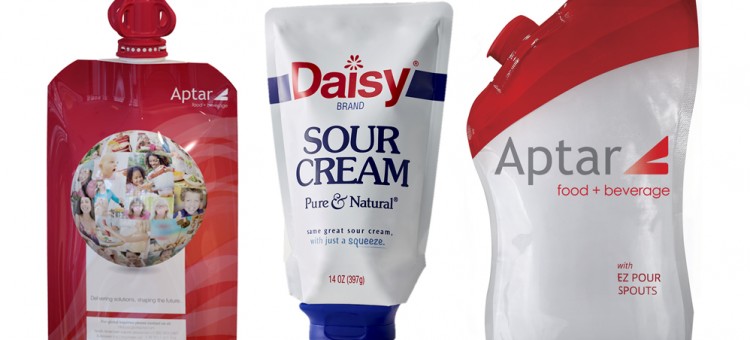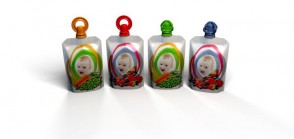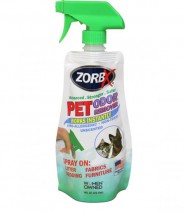
In retail, shifts in consumer purchasing decisions affect decisions made by brands. In packaging, there has been a significant shift toward flexible pouches, including those with closures that give consumers access to the product inside in a convenient, easy-to-use fashion. But variables such as lifestyle, potential for contamination and environmental concerns have also driven an increase in the development of flexible pouches with closures.
“Why would you want to scoop something out of a jar, for example, if you can squeeze it out of a pouch?” Evan Arnold, product development manager of Glenroy, says.
As more consumers adopt an on-the-go lifestyle, the products they purchase need to have the packaging to facilitate ease-of-use. Arnold explains that retail packaging in particular has been taking a turn toward more functional packaging. He continues by saying that in the coming years, he expects to see spouts, sprayers and squeezable pouches that fit with consumers’ lifestyles making major headway in the industry.
Consumers are also more willing to pay for convenience and for products they believe will be more suitable for their lifestyle. Dave Johnson, strategic business development manager for Aptar, a company specializing in dispensing systems for the packaging industry, explains that cost only matters to consumers to a certain point.
“Cost is a driver, but if the package is messier when used, harder to dispense or doesn’t perform well, then the small savings are short lived,” he says.
Johnson says that Aptar focuses on three flexible packaging categories: dispensing, inverted pouch/valve technology; and child friendly options.
Aptar’s dispensing fitments are designed with a flip top lid that enables the consumer to open and reseal the package more easily. These designs allow the consumer to pour or squeeze the product in a clean and convenient way. The majority of pouches with closures are in the food and beverage market, Johnson explains.
Inverted pouches are a relatively new concept in flexible packaging. Johnson points to one brand in particular that worked with Aptar to develop the perfect solution for its consumers’ needs. Daisy Sour Cream decided to use an inverted pouch with a flip lid closure and valve (branded as SimpliSqueeze) to increase the convenience and cleanliness of its product’s user experience.
Johnson explains that the SimpliSqueeze valve allows for clean dispensing of the sour cream by cutting off the product and preventing build up. The design also gives the consumer more directionality when applying sour cream to food, rather than using a spoon and trying to release the product from the spoon onto the desired area. Since the consumer is dispensing directly from the inverted pouch onto their food of choice, the risk of contamination from dirty utensils is eliminated. Also, because the need for a spoon or knife is eliminated, the consumer will create fewer dirty dishes, increasing convenience and cleanliness.

“Any other category where you can eliminate a knife or spoon, bring better accuracy when it comes to dispensing onto the dish or sandwich, anything that is easier for seniors or kids to use,” he says, “those are the categories that are very interested in the inverted pouch.”
Although Daisy is the first commercialized launch of an inverted pouch with a valve, Johnson explains that the success that the company has experienced with the packaging has resulted in wide market acceptance and that there are other food categories that are considering the packaging technology.
Child-friendly flexible pouches is an expanding market and is replacing rigid packaging, Johnson says. Child-friendly flexible packaging with closure options have many consumer benefits, ranging from tamper evident features, easy open options for toddlers and even the option using the SimpliSqueeze technology, which Johnson explains prevents spills from occurring if the pouch isn’t being actively squeezed. This anti-spill feature is valuable for beverages, such as for juices in a pouch.
He points to baby purees, applesauces and puddings in particular as a growth segment in spouted flexible packaging.
“I think that is driven by an on-the-go lifestyle; working families, busy moms and dads,” he says. “Being able to give a pouch to a toddler and have them independently feed themselves.”
But it also has to do with portability. Having baby food in a pouch instead of a glass jar makes for easier transport and storage.
Mercedes Candedo, new business development leader at Karlville, a global provider of flexible packaging equipment solutions, cites baby food and single servings for adult products as growing applications for spouted pouches.
“It is more convenient to carry a spouted pouch to the gym for example, rather than a bulky plastic bottle,” she says. “At Karlville, we offer manufacturing platform solutions for pouch making and spout inserting through thermal and/or ultrasonic technology welding. Ultrasonic technology allows for leak free, 100% recyclable pouches and a more efficient welding area, all key attributes that make this technology innovative and a winner when targeting sustainability goals.”
Candedo adds that spouted flexible pouches in large sizes — one liter and one gallon — are also growing in demand for multi-serve and food service segments. Raul Matos, VP of sales and marketing at Karlville, specifically mentions restaurants that don’t want to have to transport, handle and throw out large bottles.
Matos continues by saying that Karlville is focusing on two growth trends: single serve for food, and family size for home and personal care. He explains that these segments in particular are transitioning from rigid packaging to flexible pouches with spouts.
Another trend that Johnson points out is the consumer push toward more environmentally friendly packaging options. Spouted flexibles, in many cases, use less packaging and require less energy to produce, versus rigid packaging. He explains that flexible packaging can maximize the product to package ratio, over rigid formats.

Arnold mirrors this idea, noting that consumer demands have shifted packaging decisions made by brands.
“We really view flexible packaging as a carbon footprint reduction in comparison to rigid bottles,” he says. “A lot of the time, brands will come to us and they’ve already made the decision to go with flexibles, even though the infrastructure is set up for bottles. They see this trend of consumers wanting brands to be more environmentally friendly, so they move toward flexibles to make that happen.”
Arnold adds that front-mounted tap and gland features that work as a spigot on the front of a flexible pouch are a popular option for wine packaging. However, he says that the most popular closure that Glenroy sees is the press to close zipper, although that is rapidly shifting, as consumers are willing to pay more for spouted pouches. One of the issues with press to close zippers, he explains, is that products in powder form, such as protein powders, can get stuck in the zipper, preventing full closure.
Johnson says in some cases, a spout may be added to a flexible package instead of a zipper because consumers are not always confident the zipper will be fully closed. This has also contributed to the rise of flip lid caps or spouts, which consumers tend to believe provide a strong seal.
As consumer trends and concerns continue to shift, the industry will continue to evolve, but for now, it seems like advances in closures for pouches have enabled brands to maintain product integrity while meeting consumer demands.
Edit by By Ashley Roberts who is the Senior Production Editor of the Printing & Packaging Group
[ add comment ] ( 27 views ) | permalink |




 ( 2.9 / 1389 )
( 2.9 / 1389 )

 Calendar
Calendar